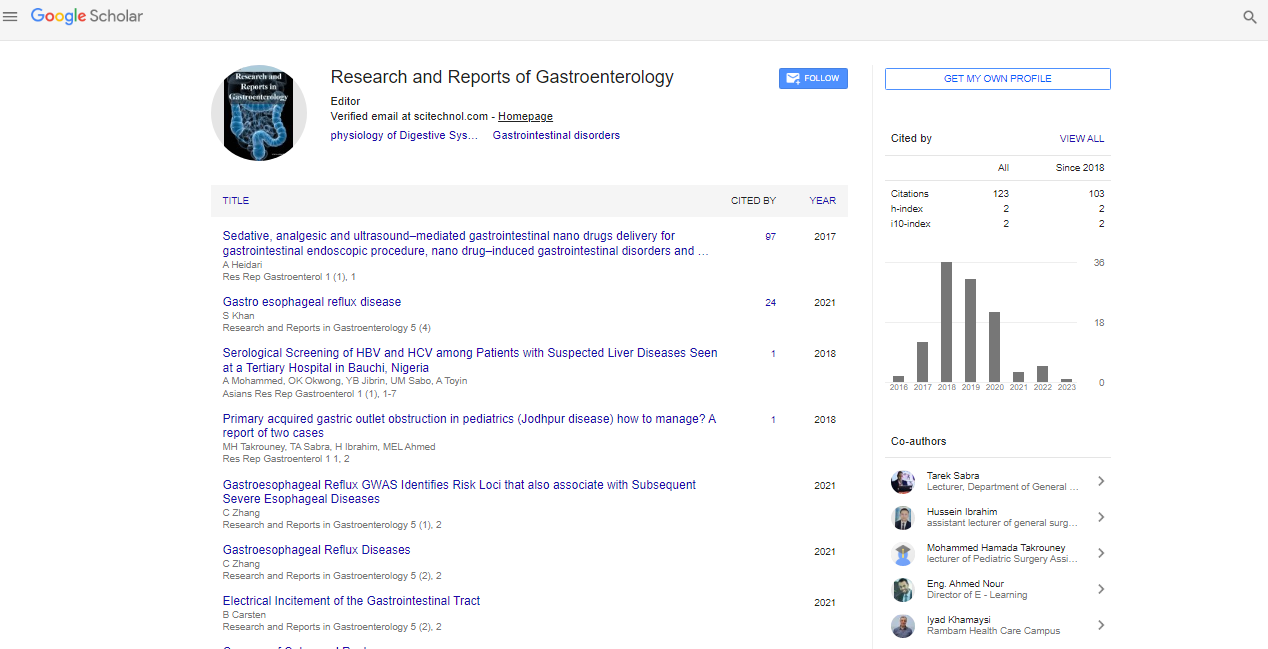Perspective, Res Rep Gastroenterol Vol: 7 Issue: 2
Novel Endoscopic Techniques for Early Detection of Colorectal Neoplasia
Juli Brian*
1Division of Gastroenterology, Icahn School of Medicine, New York, USA
*Corresponding Author: Juli Brian,
Division of Gastroenterology, Icahn School of
Medicine, New York, USA
E-mail: brianjuli@gmail.com
Received date: 15 May, 2023, Manuscript No RRG-23-106619;
Editor assigned date: 17 May, 2023, PreQC No RRG-23-106619(PQ);
Reviewed date: 01 June, 2023, QC No RRG-23-106619;
Revised date: 08 June, 2023, Manuscript No RRG-23-106619 (R);
Published date: 16 June, 2023, DOI: 10.4172/Rrg.1000143
Citation: Brian J (2023) Novel Endoscopic Techniques for Early Detection of Colorectal Neoplasia. Res Rep Gastroenterol 2023, 7:2.
Abstract
Description
Colorectal neoplasia, including precancerous polyps and early-stage colorectal cancer, is a significant global health concern. Early detection and intervention are key to improving patient outcomes. Over the years, advances in endoscopic techniques have greatly enhanced the detection and characterization of colorectal neoplasia. This article explores novel endoscopic techniques that are revolutionizing the early detection of colorectal neoplasia, leading to more accurate diagnoses and improved patient care.
Chromoendoscopy.
Chromoendoscopy involves the application of dyes or stains to the colorectal mucosa to improve lesion visualization and characterization. Traditional chromoendoscopy techniques use indigo carmine or acetic acid to enhance mucosal surface patterns and highlight subtle lesions. However, newer chromoendoscopy techniques, such as electronic chromoendoscopy and virtual chromoendoscopy, offer non-invasive alternatives. Narrow-Band Imaging (NBI) and i-scan are virtual chromoendoscopy technologies that use specific light filters to enhance the contrast of the mucosal surface, improving the detection of subtle neoplastic lesions.
Confocal laser endomicroscopy
Confocal Laser Endomicroscopy (CLE) the enables real - time microscopic imaging of the colorectal mucosa at a cellular level. It uses a laser to generate high-resolution images, providing detailed information about cellular structures and tissue architecture. CLE allows in vivo histological evaluation during endoscopy, potentially reducing the need for unnecessary biopsies. This technique is particularly useful for identifying neoplastic changes in flat or subtle lesions that may be missed by conventional endoscopy. CLE can aid in the immediate diagnosis of colorectal neoplasia, guiding appropriate treatment strategies.
Endocytoscopy
Endocytoscopy is another advanced imaging technique that allows for in vivo microscopic visualization of the colorectal mucosa. It employs high magnification to examine cellular structures in realtime, enabling real-time histopathological evaluation. Endocytoscopy offers a more detailed assessment of cellular features, such as nuclear morphology and cytoplasmic characteristics, aiding in the differentiation of neoplastic and non-neoplastic lesions. This technique has shown promise in distinguishing between adenomatous polyps and hyperplastic polyps, facilitating immediate decision-making during endoscopy.
Full-spectrum endoscopy
Full-spectrum endoscopy combines white-light imaging with advanced imaging modalities, such as NBI and autofluorescence imaging, to provide a comprehensive evaluation of the colorectal mucosa. By integrating multiple imaging techniques, full-spectrum endoscopy enhances the detection of subtle lesions and improves diagnostic accuracy. It can aid in the identification of precancerous polyps, early-stage cancers, and flat lesions that may be missed by conventional white-light endoscopy alone. Full-spectrum endoscopy offers a more detailed and comprehensive view of the colorectal mucosa, enhancing the ability to detect and diagnose colorectal neoplasia at an early stage.
Artificial intelligence
The integration of artificial intelligence and machine learning algorithms is an emerging trend in endoscopy. AI can analyze large datasets of endoscopic images and videos, assisting in real-time lesion detection and characterization. Deep learning algorithms can recognize patterns and features that may be missed by the human eye, improving the accuracy and efficiency of early neoplasia detection. AI-based systems, when combined with advanced endoscopic techniques, have the potential to significantly enhance the early detection of colorectal neoplasia.
Conclusion
Novel endoscopic techniques have revolutionized the early detection of colorectal neoplasia, enabling more accurate diagnoses and improved patient care. Chromoendoscopy, confocal laser endomicroscopy, endocytoscopy, full-spectrum endoscopy, and artificial intelligence-based systems are expanding the capabilities of endoscopy in detecting and characterizing colorectal lesions at an early stage. These advancements offer the potential for earlier intervention, precise treatment planning, and improved patient outcomes. Continued research and implementation of these novel techniques are necessary to further optimize early detection strategies and reduce the burden of colorectal neoplasia on a global scale.
 Spanish
Spanish  Chinese
Chinese  Russian
Russian  German
German  French
French  Japanese
Japanese  Portuguese
Portuguese  Hindi
Hindi 